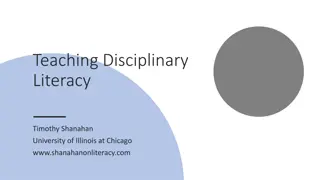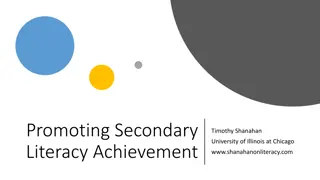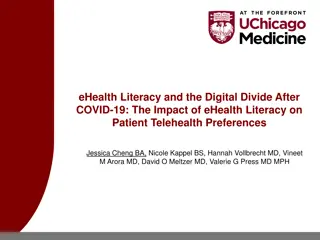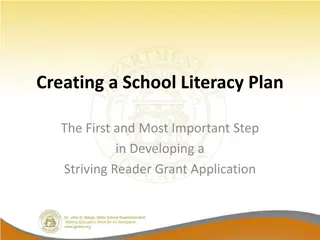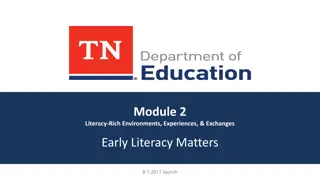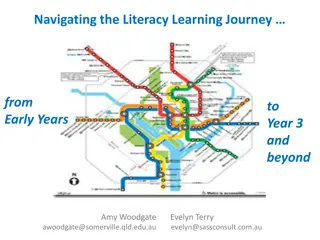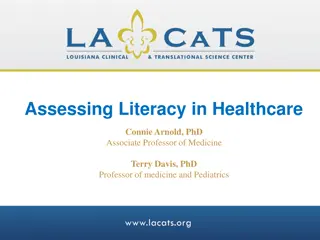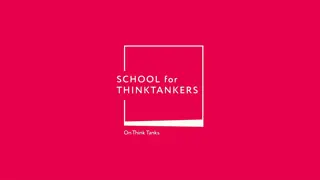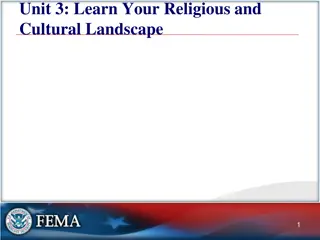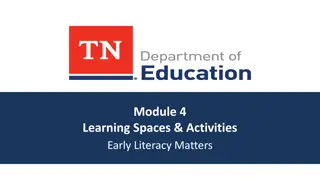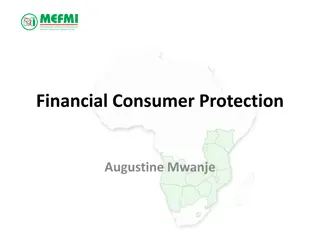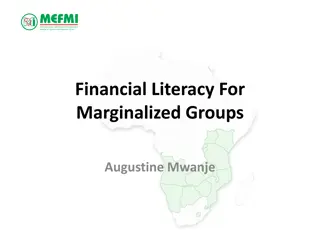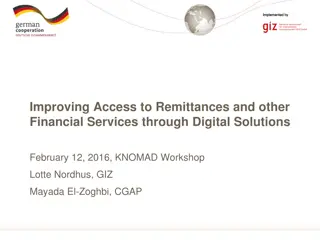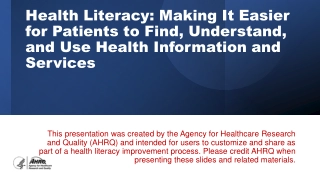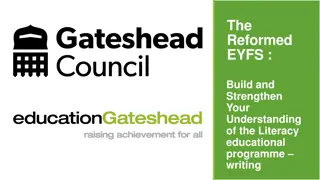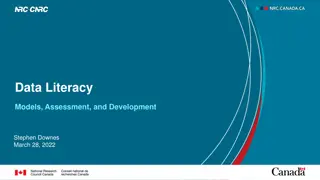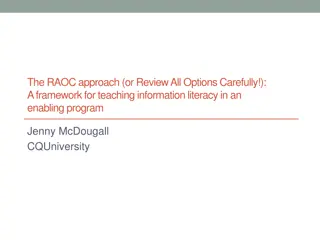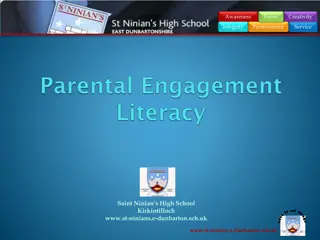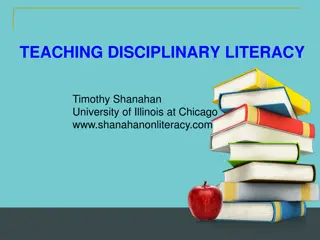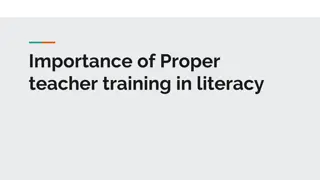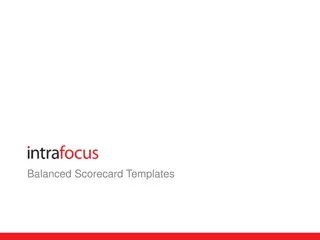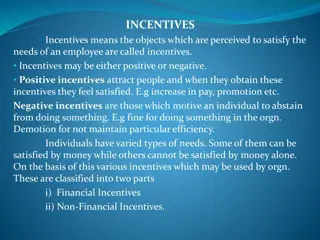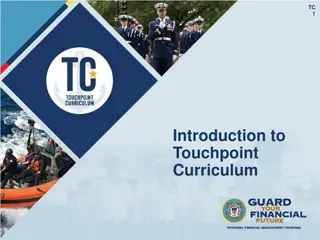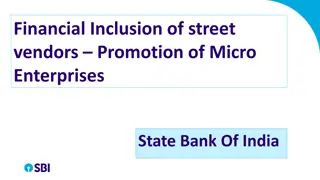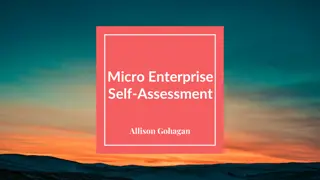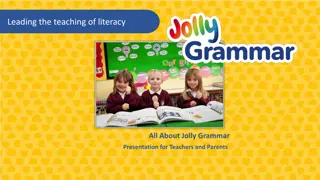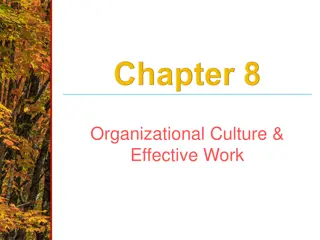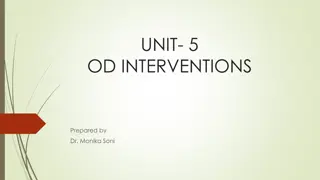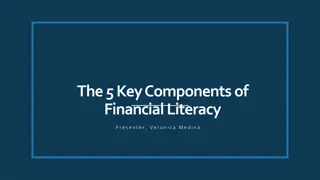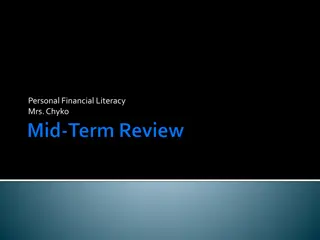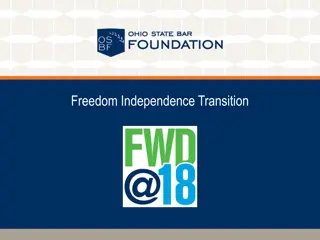Enhancing Financial Literacy for Better Organizational Performance
Explore the importance of financial literacy for managers and executives, as highlighted in various studies. Learn about the common gaps in financial knowledge and the essential elements of financial statements. Test your understanding with pre-test questions on cash, collections, and company cash flow. Set clear objectives to identify and understand key financial statements, math relationships, and the distinction between profit and cash. Enhance your financial literacy to become part of the solution and improve organizational success.
Download Presentation

Please find below an Image/Link to download the presentation.
The content on the website is provided AS IS for your information and personal use only. It may not be sold, licensed, or shared on other websites without obtaining consent from the author. Download presentation by click this link. If you encounter any issues during the download, it is possible that the publisher has removed the file from their server.
E N D
Presentation Transcript
OCMS Leadership Secrets of Financial Statements What to Know without Memorizing Oct 1, 2022 Andrew C. Gin, MD, MSPA
Financial Literacy Problem is Common Harvard Business Review, 2009 and New York Times, 2002 21 Questions on Financial Basics American managers, Fortune 500 officers and directors Correct answers: 32-38%, many FAILED miserably For your organization, are you part of the problem or part of the solution?
The Knowledge Gap Finding and Filling Basic Financial Literacy Gaps in your organizations and yourselves ... a representative sample of U.S. managers from C-level executives to supervisors scored an average of only 38% [on a basic financial-literacy exam]. A majority were unable to distinguish profit from cash. Many didn t know the difference between an income statement and a balance sheet.
Objectives You Will Be Able To Identify 4 Main Financial Statements Balance Sheet Income Statement (P&L, Rev. over Exp.) Cash Flow Statement, (Indirect, Direct) Statement of Retained Earnings Elements of Each Financial Statement Math Relationships of Elements in Each Math Relationships Among All Statements And Demonstrate Knowledge of Profit and Cash applicable to ANY Set of Financial Statements
Pre-Test 1 Q: Cash is shown on (Choose all that apply): a) Beginning and Ending Balance Sheets b) Income (Profit-Loss) Statement c) Cash Flow Statement d) Statement of Retained Earnings
Pre-Test 2 Q: Collections is on (Choose all that apply): a) Beginning and Ending Balance Sheets b) Income Statement c) Cash Flow Statement d) Direct Cash Flow Statement e) Statement of Retained Earnings
Pre-Test 3 Q: A company has more CASH today when (Choose all that apply): a) Customers pay their bills sooner b) Accounts receivable increases c) Profits increase d) Retained earnings increases
Financial Statement - Separate Sheets E. Bal Sh B.Bal Sh Income Cash Flow Cash 210 0 Work 240 Salary Paid 240 Acct Rec. 0 0 Bills Owed 30 Bills Paid 30 Acct Pay. 0 0 Profit 210 Net Cash 210 Ret. Earn 210 0 Cash Flow Ret Earn What you usually get is an Indirect Cash Flow Statement and Statement of Retained Earnings as: Net Proftit 210 Beg. RE 0 -Chg AR 0 Net Profit 210 +Chg AP 0 End RE 210 Net Cash 210
Simple Start The Individual Working = exchange time for monetary value (dollars) o Employee is of value to employer o Employer is of value to employee Volunteering = exchange time for non- monetary value (purpose)
Think Data is Separate but Interconnected 1) Balance Sheets, Beginning and Ending 2) Income Sheet, Profit/Loss Statement, Revenue over Expense Statement, etc. 3) Cash Flow Statement, direct and indirect 4) Statement of Retained Earnings
Main Ideas Assets = Liabilities + Equity Vertical calculations Horizontal calculations Direct and Indirect Cash Flows Current Financial Statements, as OSMA, OCMS
Fundamental Accounting Equation A = L+ E: Know 2 terms, Calc 3rd term Assets Liabilities = Equity Assets = Liabilities + Equity What you: Have Still Owe = Really Own Have = Still Owe + Really Own Have (A) Owe (L) Own (E)
Bathtub Analogy (Levels and Flows) A tub with a single faucet and faulty plug: At any point in time, the amount of water in tub (water level) depends on rate of water flow in AND water flow out. The level is rarely constant
For Financial Statements Two Main Levels What You are Promised to be paid, Accounts Receivable What You Promise to pay other, Accounts Payable. Four Main Flows 1. Promised Inflow: Work, Salary, $/hr 2. Actual Inflow: Paycheck, $ for work done 3. Promised Outflow: Rent, Credit card purchase 4. Actual Outflow: Rent paid, CC payment.
Individual: End of Day 1 Promise Pay Difference What You Sell ( $ in ) Work Salary Paid Still Owed 8 hr $0 8 hr * $10/ hr = $80 Bills Owed Bills Paid Still Owe What You Buy ( $ out) 1 day Rent @ $30/mo $0 1 Month / 30 day Rent = $1
Individual: End of Month Before Getting Paid and Paying Rent Promise Pay Difference What You Sell ( $ in ) Work Salary Paid Still Owed $80*30 = $240 $0 $240 Bills Owed Bills Paid Still Owe What You Buy ( $ out) $1*30= $30 $0 $30
Individual: End of Month After Getting Paid and Paying Rent Promise Pay Difference What You Sell ( $ in ) Work Salary Paid Still Owed $240 $240 $0 Bills Owed Bills Paid Still Owe What You Buy ( $ out) $30 $30 $0
Financial Statement - Informal Work 240 Salary Paid 240 Owed 0 Bills Owed 30 Bills Paid 30 Owe 0 Profit 210 Net Worth 210 Net Cash 210 Cash 210 Let s relabel the right column: Work 240 Salary Paid 240 Acct. Rec 0 Bills Owed 30 Bills Paid 30 Acct. Pay 0 Profit 210 Ret Earn 210 Net Cash 210 Cash 210
Financial Statement - As Single Tables Acct Rec. 0 Work 240 Salary Paid 240 Acct. Rec 0 Acct Pay. 0 Bills Owed 30 Bills Paid 30 Acct. Pay 0 Ret. Earn 0 Profit 210 Ret Earn 210 Cash 0 Net Cash 210 Cash 210 Cash (an Asset) is King, so Move it to the top. Math relationships remain unchanged B. Bal Sh Income Cash Flow E. Bal Sh Cash 0 Net Cash 210 Cash 210 Acct Rec. 0 Work 240 Salary Paid 240 Acct. Rec 0 Acct Pay. 0 Bills Owed 30 Bills Paid 30 Acct. Pay 0 Ret. Earn 0 Profit 210 Ret Earn 210
More Generic Labelling and Insight B. Bal Sh Income Cash Flow E. Bal Sh Cash 0 Net Cash 210 Cash 210 Acct Rec. 0 Revenues 240 Collections 240 Acct. Rec 0 Acct Pay. 0 Expenses 30 Exp. Paid 30 Acct. Pay 0 Ret. Earn 0 Net Profit 210 Ret Earn 210 Revenues and Expenses are promises Collections and Exp. Paid are fulfillment of promises You can not spend profit. Cash depends on collections and controlling expenses Bath tub analogy (Flow and levels) Income and Cash Flow rise and fall over time. Balance sheets mark the level at instant of time. Let s review: Vertical calculations, within each statement Horizontal calculations, linking the statements
Vertical Calculations B. Bal Sh Income Cash Flow E. Bal Sh Cash 0 =Net Cash 210 Cash 210 +Acct Rec. 0 Revenues 240 +Collections 240 +Acct. Rec 0 =Acct Pay. 0 -Expenses 30 -Exp. Paid 30 =Acct. Pay 0 +Ret. Earn 0 =Net Profit 210 +Ret Earn 210
Horizontal Calculations B. Bal Sh Income Cash Flow E. Bal Sh Cash 0 +Net Cash 210 =Cash 210 Acct Rec. 0 +Revenues 240 -Collections 240 =Acct. Rec 0 Acct Pay. 0 +Expenses 30 -Exp. Paid 30 =Acct. Pay 0 Ret. Earn 0 +Net Profit 210 =Ret Earn 210
Financial Statement - Separate Sheets E. Bal Sh B.Bal Sh Income Cash Flow Cash 210 0 Work 240 Salary Paid 240 Acct Rec. 0 0 Bills Owed 30 Bills Paid 30 Acct Pay. 0 0 Profit 210 Net Cash 210 Ret. Earn 210 0 Cash Flow Ret Earn What you usually get is an Indirect Cash Flow Statement and Statement of Retained Earnings as: Net Proftit 210 Beg. RE 0 -Chg AR 0 Net Profit 210 +Chg AP 0 End RE 210 Net Cash 210
Post-Test 1 Q: Cash is shown on (Choose all that apply): a) Beginning and Ending Balance Sheets <- Yes b) Income (Profit-Loss) Statement <- No c) Cash Flow Statement <- Yes d) Statement of Retained Earnings <- No
Post-Test 2 Q: Collections is on (Choose all that apply): a) Beginning and Ending Balance Sheets <- No b) Income Statement <- No c) Indirect Cash Flow Statement <- No d) Direct Cash Flow Statement <- Yes e) Statement of Retained Earnings <- No
Post-Test 3 Q: A company has more CASH today when (Choose all that apply): a) Customers pay their bills sooner <- Yes a) Accounts receivable increases <- No b) Profits increase <- No c) Retained earnings increases <- No
Next Step? OSMA/OCU at Meinders School of Business 1 year for certificate , 9-weeks x 5 courses 1 more year for full MBA Ask colleagues and OSMA/OCU graduates Call OSMA (405)-601-9571, Wes Glinsmann Call OCU (405)-208-5154, Cindy Treadway Call Me (405)-682-9955
Reference 1 Financial Basic for Managers , HBR Press, 2012, ISBN: 978-1-4221-8730-2, page 73-82. Are Your People Financially Literate? , K. Berman and J. Knight, Harvard Business Review, Oct 2009, Reprint F0910D.






